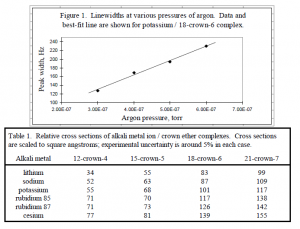Daniel E. Austin and Dr. David Dearden, Chemistry and Biochemistry
I explored the possibility of using spectral linewidths in a Fourier transform ion cyclotron resonance mass spectrometer (FTICR-MS) to measure ion collision cross sections. A measurement of an ion’s collision cross section would provide important information about its conformation, or the spatial arrangement of the atoms and functional groups that make up the ion.
In an FTICR cell, gas-phase ions are excited, as a group, into a cyclotron orbit, and the resulting electric field oscillations are measured for a period of time. A Fourier transform of this signal gives a frequency-domain spectrum, where each type of ion is represented by a peak. Under normal, optimized conditions, these peaks are very narrow. However, by increasing the background pressure, the peaks become broadened. This pressure-broadening is the result of the gradual loss of timedomain signal as individual ions collide with neutral molecules and are knocked out of the cyclotron group (1). The frequency with which ions collide with neutral molecules is proportional to the average collision cross section (or cross-sectional area) of the ions and the neutral molecules. In previous work done at BYU, Nicoll and co-workers showed that this pressure-broadening can be used to measure the background pressure in an FTICR cell when the ion cross section is known (2,3). For my project I worked in the reverse direction: if the background pressure is known, how well can the cross section of an ion of interest be measured?
I first measured the effect of background pressure on the spectral line for the potassium / 18-crown-6 complex ion, using various pressures of argon. This ionic complex has been studied extensively using other methods and its cross section is known. The lowest pressure of argon at which pressure induced peak broadening was significant was 3.00 × 10-7 torr. The highest pressure at which a good signal could be obtained was 6.00 × 10-7 torr. Figure 1 shows the results of these experiments. Each data point represents the average peak width of 384 scans. The data show that, within the limited range of pressures possible, the peak width is directly proportional to the background pressure.
Since the optimum argon pressure for these experiments was around 5.00 × 10-7 torr, I studied several other complex ion systems at this pressure, including all the combinations of lithium, sodium, potassium, rubidium 85, rubidium 87, and cesium with 12-crown-4, 15-crown-5, 18-crown-6, and 21-crown-7. The peak widths of these complexes showed the same trends that had been measured by other methods (4). These data are shown in table 1.
It was my original intention to fit each spectral peak to a Lorentzian curve, and then use the full width at half max to try to determine the relationship between pressure and peak width. I found, however, that the spectral peaks are not well represented by Lorentzian curves, as previously thought. In an article accepted for print but not yet published, Marshall and co-workers note and discuss this same problem (5). We both found that the spectral peaks were narrower in the middle and broader at the base than Lorentzian peaks. Marshall and coworkers offered an explanation of the cause of the problem, but not a way of calculating it. I spent some time looking over the theory behind the situation, and trying to find an equation that could be used to predict it, but I could not. Most likely, FTICR-MS could still be used to measure collision cross sections without knowing the exact nature of this perturbation. The above work was used in my Honors Thesis; more details and discussion can be found there (6,7).
References
- Comisarow, M.B. J. Chem. Phys. 1978, 69(9), 4097-4104.
- Nicoll, J.B. MS Thesis, Brigham Young University, Aug 1997.
- Nicoll, J.B.; Kellersberger, K.; Dejsupa, C.; Dearden, D.V. in progress.
- Lee, S.; Wyttenbach, T.; von Helden, G.; Bowers, M.T. J Am. Chem. Soc. 1995, 117, 10159- 10160.
- Guan, S.; Li, G.; Marshall, A.G., in press.
- Austin, D.E. BS Honors Thesis, Brigham Young University, Mar. 1998.
- Assistance on this project was provided by Dr. David Dearden, Jeremy Nicoll, and Yongjiang Liang. Funding was provided by the BYU Office of Research and Creative Activities.

